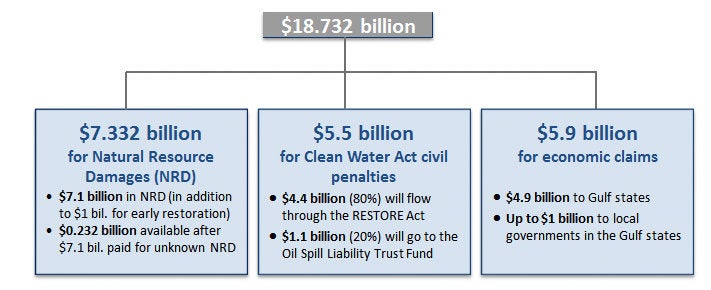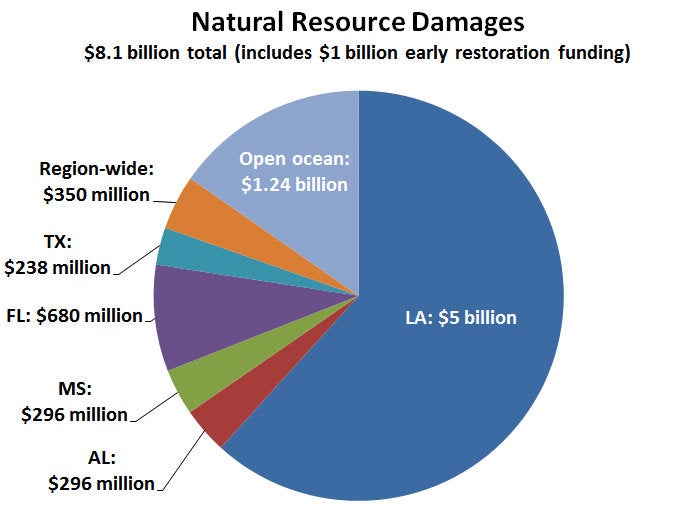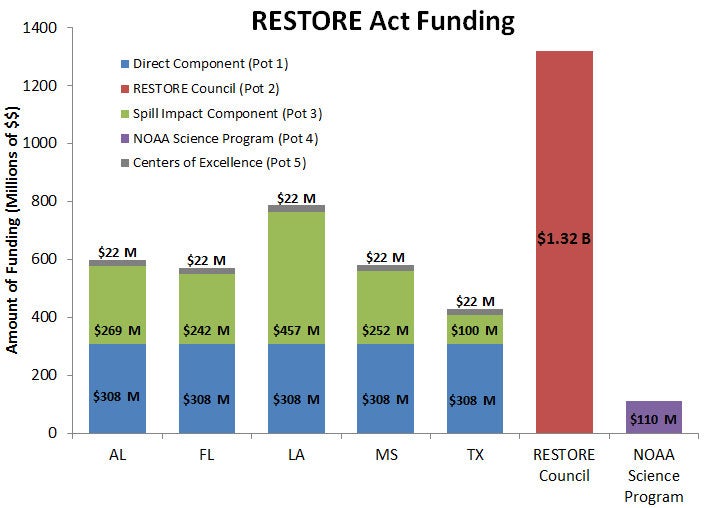Deepwater Horizon Settlement – Some Answers, New Questions
This information was originally posted on the Environmental Law Institute’s website.
By ELI Gulf Team
On July 2, 2015, a monumental announcement was made: an agreement in principle has been reached to settle all federal and state claims against BP arising from the Deepwater Horizon oil spill for $18.732 billion (see BP’s press release here). This amount includes:
While we are still waiting on the exact details of the settlement, we do know some of the terms. We will focus on the natural resource damages and Clean Water Act civil penalties (specifically the RESTORE Act) here, considering:
1. What do we know?
2. What were the potential damages or penalties?
3. What information is still missing?
Note that this agreement is by no means final: the details still need to be hammered out and, once they are, they will be set out in a consent decree, which will be open for public comment before it goes to the court for final approval.
Natural Resource Damages (NRD)
As a refresher, a Natural Resource Damage Assessment is a process focused on restoring natural resources injured by an oil spill. The goal is to restore the resources to the condition they would have been in had the oil spill not occurred (called “baseline”). This process is led by government representatives called “trustees.” The parties responsible for the spill pay for, among other things, the costs of restoration.
1. What do we know?
BP has agreed to pay $7.1 billion in natural resource damages. This is in addition to the $1 billion already committed for early restoration. The $8.1 billion total is divided as follows:
Louisiana will receive the bulk of the funding (over 60%). Notably, over $1 billion will go to open ocean projects, which have not received a substantial amount of funding under early restoration.
A few additional notes:
- The money will be paid out over 15 years
- Interest will accrue on the unpaid balance; this interest is payable the year after the last NRD payment, but the Gulf states and federal government may request payment of the accrued interest after 10 years to address unknown natural resource damages
- An additional $232 million will be made available for unknown natural resource damages the year after the $7.1 billion is paid
- An additional $350 million will be paid for costs related to assessing the natural resource damages
2. What were the potential damages?
Natural resource damages were in the process of being assessed when the agreement was announced. Evaluation of damages is complicated, and we will know more about the quantification of damages after more information is released (much of it was confidential due to the potential for litigation).
3. What information is still missing?
There is still information we do not know, including:
- The terms under which the interest can be accessed early
- The terms under which the additional $232 million can be accessed
- What types of restoration projects will be chosen
- The timeline for the restoration plan(s) and implementing projects
As for participation opportunities, in addition to commenting on the terms of the consent decree, there will be opportunities for the public to comment on the restoration plan(s) and projects. We will post these opportunities on our Public Participation Bulletin Board as they arise.
RESTORE Act
As a refresher, the RESTORE Act diverts 80% of Clean Water Act civil and administrative penalties collected as a result of the Deepwater Horizon oil spill to the Gulf for restoration and recovery. The funds go to five different “pots” (learn more here).
1. What do we know?
BP has agreed to pay $5.5 billion in Clean Water Act civil penalties, which means that $4.4 billion (80% of $5.5 billion) will flow through RESTORE. The graph below shows how this $4.4 billion will be allocated:
Among the states, Louisiana is slated to receive the most RESTORE Act funding (18% of the RESTORE funds). Florida, Alabama, and Mississippi will receive around 14% of the RESTORE funds, with Texas receiving 10%.
A few additional notes:
- The money will be paid out over 15 years
- Interest will accrue on the balance, payable the year the last RESTORE Act payment is made
- Adding the $4.4 billion to the $800 million already flowing through RESTORE (from the Transocean settlement), a total of $5.2 billion has now been obligated to RESTORE
2. What were the potential penalties?
BP’s Clean Water Act civil penalties were the subject of ongoing litigation (see our post on the trial here). The court had not released a decision on the penalty amount before the settlement announcement. At the time of the announcement, BP faced a $13.7 billion maximum penalty.
3. What information is still missing?
At this time, we don’t know how the states will spend their share of the funding and what their priorities will be (though Louisiana is expected to fund projects from its Coastal Master Plan). We also don’t know what types of projects the RESTORE Council will prioritize for funding.
As for participation opportunities, in addition to commenting on the consent decree, there will be state-specific and Gulf-wide participation opportunities. We will track these on our Public Participation Bulletin Board.
New Questions
Once the details of the agreement are fleshed out, there will be answers to many of our remaining questions. A number of questions will nonetheless persist – particularly on which projects will be chosen and how they will be implemented. It is therefore essential that the public remain involved and participate as the restoration processes move forward. While the agreement represents a monumental step forward, it is just the start of a long recovery road ahead.
For more information on the Environmental Law Institute’s Ocean Program, click here.


